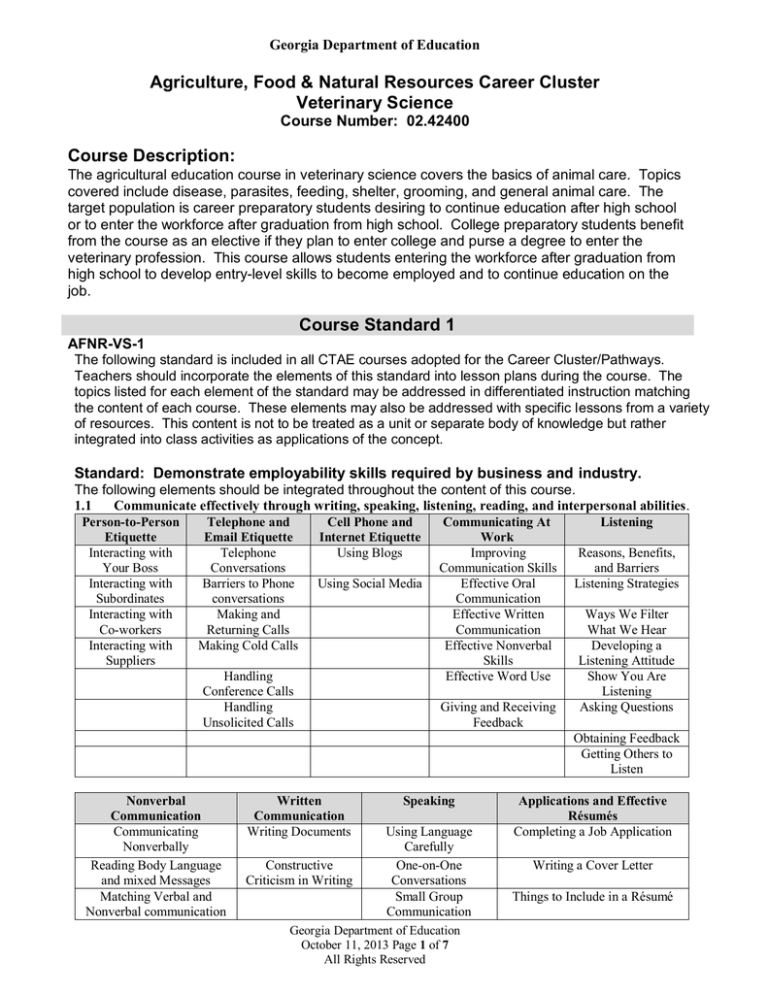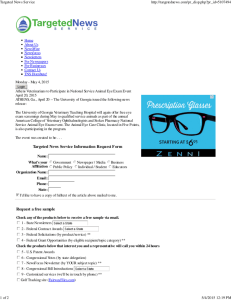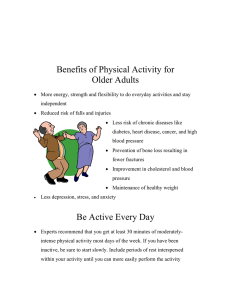
Georgia Department of Education
Agriculture, Food & Natural Resources Career Cluster
Veterinary Science
Course Number: 02.42400
Course Description:
The agricultural education course in veterinary science covers the basics of animal care. Topics
covered include disease, parasites, feeding, shelter, grooming, and general animal care. The
target population is career preparatory students desiring to continue education after high school
or to enter the workforce after graduation from high school. College preparatory students benefit
from the course as an elective if they plan to enter college and purse a degree to enter the
veterinary profession. This course allows students entering the workforce after graduation from
high school to develop entry-level skills to become employed and to continue education on the
job.
Course Standard 1
AFNR-VS-1
The following standard is included in all CTAE courses adopted for the Career Cluster/Pathways.
Teachers should incorporate the elements of this standard into lesson plans during the course. The
topics listed for each element of the standard may be addressed in differentiated instruction matching
the content of each course. These elements may also be addressed with specific lessons from a variety
of resources. This content is not to be treated as a unit or separate body of knowledge but rather
integrated into class activities as applications of the concept.
Standard: Demonstrate employability skills required by business and industry.
The following elements should be integrated throughout the content of this course.
1.1
Communicate effectively through writing, speaking, listening, reading, and interpersonal abilities.
Person-to-Person
Telephone and
Cell Phone and
Communicating At
Listening
Etiquette
Email Etiquette
Internet Etiquette
Work
Interacting with
Telephone
Using Blogs
Improving
Reasons, Benefits,
Your Boss
Conversations
Communication Skills
and Barriers
Interacting with
Barriers to Phone
Using Social Media
Effective Oral
Listening Strategies
Subordinates
conversations
Communication
Interacting with
Making and
Effective Written
Ways We Filter
Co-workers
Returning Calls
Communication
What We Hear
Interacting with
Making Cold Calls
Effective Nonverbal
Developing a
Suppliers
Skills
Listening Attitude
Handling
Effective Word Use
Show You Are
Conference Calls
Listening
Handling
Giving and Receiving
Asking Questions
Unsolicited Calls
Feedback
Obtaining Feedback
Getting Others to
Listen
Nonverbal
Communication
Communicating
Nonverbally
Reading Body Language
and mixed Messages
Matching Verbal and
Nonverbal communication
Written
Communication
Writing Documents
Speaking
Using Language
Carefully
Constructive
One-on-One
Criticism in Writing
Conversations
Small Group
Communication
Georgia Department of Education
October 11, 2013 Page 1 of 7
All Rights Reserved
Applications and Effective
Résumés
Completing a Job Application
Writing a Cover Letter
Things to Include in a Résumé
Georgia Department of Education
Improving Nonverbal
Indicators
Nonverbal Feedback
Showing Confidence
Nonverbally
Showing Assertiveness
1.2
Large Group
Communication
Making Speeches
Involving the
Audience
Answering Questions
Visual and Media Aids
Errors in Presentation
Selling Yourself in a Résumé
Terms to Use in a Résumé
Describing Your Job Strengths
Organizing Your Résumé
Writing an Electronic Résumé
Dressing Up Your Résumé
Demonstrate creativity by asking challenging questions and applying innovative procedures and
methods.
Teamwork and Problem Solving
Meeting Etiquette
Thinking Creatively
Preparation and Participation in Meetings
Taking Risks
Conducting Two-Person or Large Group Meetings
Building Team Communication
Inviting and Introducing Speakers
Facilitating Discussions and Closing
Preparing Visual Aids
Virtual Meetings
1.3
Exhibit critical thinking and problem solving skills to locate, analyze and apply information in
career planning and employment situations.
Problem
Customer Service The Application Process
Interviewing
Finding the Right
Solving
Skills
Job
Transferable
Gaining Trust and
Providing Information,
Preparing for an
Locating Jobs and
Job Skills
Interacting with
Accuracy and Double
Interview
Networking
Customers
Checking
Becoming a
Learning and
Online Application
Questions to Ask in
Job Shopping
Problem Solver
Giving Customers
Process
an Interview
Online
What They Want
Identifying a
Keeping Customers
Following Up After
Things to Include in
Job Search
Problem
Coming Back
Submitting an Application
a Career Portfolio
Websites
Becoming a
Seeing the
Effective Résumés:
Traits Employers
Participation in Job
Critical Thinker
Customer’s Point
are Seeking
Fairs
Managing
Selling Yourself and Matching Your Talents to
Considerations
Searching the
the Company
a Job
Before Taking a Job
Classified Ads
Handling Customer
When a Résumé Should
Using Employment
Complaints
be Used
Agencies
Strategies for
Landing an
Customer Service
Internship
Staying Motivated
to Search
1.4
Model work readiness traits required for success in the workplace including integrity, honesty,
accountability, punctuality, time management, and respect for diversity.
Workplace
Personal
Employer
Business Etiquette
Communicating at
Ethics
Characteristics
Expectations
Work
Demonstrating
Demonstrating a
Behaviors Employers
Language and
Handling Anger
Good Work Ethic
Good Attitude
Expect
Behavior
Behaving
Gaining and
Objectionable
Keeping Information
Dealing with
Appropriately
Showing Respect
Behaviors
Confidential
Difficult Coworkers
Maintaining
Demonstrating
Establishing
Avoiding Gossip
Dealing with a
Honesty
Responsibility
Credibility
Difficult Boss
Playing Fair
Showing
Demonstrating Your
Appropriate Work
Dealing with
Dependability
Skills
Email
Difficult Customers
Georgia Department of Education
October 11, 2013 Page 2 of 7
All Rights Reserved
Georgia Department of Education
Using Ethical
Language
Showing
Responsibility
Reducing
Harassment
Respecting
Diversity
Making
Truthfulness a
Habit
Leaving a Job
Ethically
Being Courteous
Gaining
Coworkers’ Trust
Persevering
Handling
Criticism
Showing
Professionalism
Building Work
Relationships
Cell Phone Etiquette
Dealing with Conflict
Appropriate Work
Texting
Understanding
Copyright
Social Networking
1.5
Apply the appropriate skill sets to be productive in a changing, technological, diverse workplace
to be able to work independently and apply team work skills.
Expected Work Traits
Teamwork
Time Management
Demonstrating Responsibility
Teamwork Skills
Managing Time
Dealing with Information Overload
Reasons Companies Use Teams
Putting First Things First
Transferable Job Skills
Decisions Teams Make
Juggling Many Priorities
Managing Change
Team Responsibilities
Overcoming Procrastination
Adopting a New Technology
Problems That Affect Teams
Organizing Workspace and Tasks
Expressing Yourself on a Team
Staying Organized
Giving and Receiving Constructive
Finding More Time
Criticism
Managing Projects
Prioritizing Personal and Work Life
1.6
Present a professional image through appearance, behavior and language.
On-the-Job Etiquette Person-to-Person Etiquette Communication Etiquette
Presenting Yourself
Using Professional
Meeting Business
Creating a Good Impression
Looking Professional
Manners
Acquaintances
Introducing People
Meeting People for the First
Keeping Phone Calls
Dressing for Success
Time
Professional
Appropriate Dress
Showing Politeness
Proper Use of Work Email
Showing a Professional
Attitude
Business Meal
Proper Use of Cell Phone
Using Good Posture
Functions
Behavior at Work
Proper Use in Texting
Presenting Yourself to
Parties
Associates
Behavior at
Accepting Criticism
Conventions
International Etiquette
Demonstrating
Leadership
Cross-Cultural Etiquette
Working in a Cubicle
Support of CTAE Foundation Course Standards and Georgia Standards of Excellence
L9-10RST 1-10 and L9-10WHST 1-10:
Georgia Standards of Excellence ELA/Literacy standards have been written specifically for
technical subjects and have been adopted as part of the official standards for all CTAE courses.
Georgia Department of Education
October 11, 2013 Page 3 of 7
All Rights Reserved
Georgia Department of Education
Course Standard 2
AFNR-VS-2
Learn to work safely in the agriculture lab and work sites, demonstrate selected
competencies in leadership through the FFA and agricultural industry organizations, and
develop plans for a supervised agricultural experience program (SAEP).
2.1 Explain the role of the Agricultural Education program and the FFA in personal development.
2.2 Demonstrate knowledge learned through a Supervised Agricultural Experience Program
(SAEP).
2.3 Develop leadership and personal development skills through participation in the FFA.
2.4 Explore career opportunities in agribusiness through the FFA and Agricultural Education
Program.
2.5 Explore the professional agricultural organizations associated with the course content.
Course Standard 3
AFNR-VS-3
Define types of hazards common in the veterinary hospital and the organization that
regulates safety standards in the workplace.
3.1 Read a material safety data sheet (MSDS) and locate important safety information.
3.2 Demonstrate the solving of mathematical equations to determine chemical
concentrations.
3.3 Determine the appropriate safety precautions for a given scenario.
3.4 Formulate percentages and averages, as well as liquid and linear measurement, including
converting English and metric units.
3.5 Demonstrate the proper and safe handling and restraint of animals.
3.6 Define and explain the purpose of the Occupational Safety and Health Administration
(OSHA) organization.
3.7 Recognize how to protect themselves from potential hazards in the workplace.
3.8 Describe the correct methods of protection given scenarios describing hazardous
situations.
3.9 Research zoonotic diseases using the Internet.
Course Standard 4
AFNR-VS-4
Distinguish the differences between sanitation, disinfection, and sterilization, and be
able to identify which cleaning method should be used in any given situation.
4.1 Describe the different methods of sanitation and know when to use them.
4.2 Provide examples of the four types of safety hazards.
Course Standard 5
AFNR-VS-5
Recognize and explain Greek and Latin prefixes, suffixes, and roots that compose the
language of veterinary medicine, as well as dissect the meaning of veterinary terms.
5.1 Analyze veterinary terms to define the meanings.
5.2 Recognize common Greek and Latin prefixes, suffixes, and roots.
5.3 List and provide examples of abbreviations commonly used in veterinary medicine.
Georgia Department of Education
October 11, 2013 Page 4 of 7
All Rights Reserved
Georgia Department of Education
Course Standard 6
AFNR-VS-6
Investigate body systems and construct a working knowledge of the function, and
purpose, including the effect on diseases.
6.1 Recognize and implement common anatomical terminology.
6.2 Apply knowledge of veterinary anatomy through the dissection of animal specimens.
6.3 Identify common intramuscular injection sites.
6.4 Recall common sites for measuring pulses and collecting blood samples.
6.5 Describe the functions of the skeletal, muscular, circulatory, respiratory, renal, digestive,
reproductive, endocrine, and nervous systems.
6.6 Apply knowledge by reading and analyzing several professional journal articles .
Course Standard 7
AFNR-VS-7
Define vocabulary of directional anatomical terms and identify anatomical structures
of animals.
7.1 Identify and relate the bones of the skeleton to a live animal.
7.2 Identify and relate the ten muscles to a live animal.
7.3 Identify and describe the parts of the upper and lower respiratory tract.
7.4 Identify and describe the parts of nerve cells and the brain.
7.5 Interpret how the body seeks to maintain a state of homeostasis.
7.6 Apply knowledge by dissection and assembling anatomical models.
Course Standard 8
AFNR-VS-8
Critique the various regions of an animal’s body and the signs of illness that may be
present.
8.1 Correctly operate the stethoscope, otoscope, and ophthalmoscope.
8.2 Properly communicate with others to obtain a history of an animal as part of a routine
physical exam.
8.3 Site evidence of certain signs and symptoms that may indicate a variety of diseases
and/or other health problems.
Course Standard 9
AFNR-VS-9
Perform several common veterinary hospital procedures.
9.1 Calculate medication amounts.
9.2 Properly label medications.
9.3 Demonstrate completing vaccinations schedules, reading and filling syringes, and
bandaging and brushing teeth.
Course Standard 10
AFNR-VS-10
Differentiate common internal and external parasites of small and large animals and
recall both the common and the scientific names.
10.1 Describe the general clinical signs of an animal with a parasite infestation.
10.2 Diagram the life cycles of internal and external parasites.
10.3 Properly use a microscope to scan for parasite eggs.
10.4 Perform common laboratory procedures for diagnosing parasites.
Georgia Department of Education
October 11, 2013 Page 5 of 7
All Rights Reserved
Georgia Department of Education
10.5 Summarize the modes of transmission, life cycle, including the procedures commonly
used to diagnose and determine the effect on the host.
Course Standard 11
AFNR-VS-11
Analyze animal nutrition required to maintain a healthy animal.
11.1 Define the terms digestion, absorption, and metabolism and describe the processes.
11.2 Discuss the differences between ruminant and non-ruminant digestive systems.
11.3 Identify and calculate an animal’s energy requirements, based on use and stage of life.
11.4 Relate the importance of the importance of guaranteed analysis in selecting animal feed.
11.5 Illustrate animal digestive systems, as well as classify feeds into nutrient groups and list
the steps of the digestion process.
11.6 Formulate rations and identify the nutrients found in various animal feeds, and conduct
a palatability study to gain an understanding of feed selection.
Course Standard 12
AFNR-VS-12
Identify and describe the various components of an animal feed label and make an
educated decision on which feed to purchase for an animal in each of the production
periods.
12.1 Conduct a feed nutrients lab to identify the level of nutrients in various animal feeds.
12.2 Evaluate various feed labels to determine the nutrient components and the quality.
12.3 Determine market strategies for various feed labels.
12.4 Conduct a palatability study to identify animal feed preferences.
12.5 Apply concepts in the marketing of pet food and assess cost comparisons of various feeds.
Course Standard 13
AFNR-VS-13
Identify the path a disease takes and access the effects on various body systems.
13.1 Describe the signs of disease.
13.2 Explain how different diseases affect the body and the methods used to treat the diseases.
Course Standard 14
AFNR-VS-14
Apply concepts of the importance of animals and the contributions that animals make
in society.
14.1 Explain the human and animal bond.
14.2 List and describe the ways in which animals are a part of human lives.
Course Standard 15
AFNR-VS-15
Identify and explain the purpose of the most common breeds of animal species and
discuss specific temperament/behavior characteristics of the breed.
15.1 Identify by sight and describe the common breeds of animals.
15.2 Demonstrate various methods of behavior modification.
Georgia Department of Education
October 11, 2013 Page 6 of 7
All Rights Reserved
Georgia Department of Education
Course Standard 16
AFNR-VS-16
Critique animal behavior through observation and draw conclusions on the interaction
with other animals, humans and environment.
16.1 Discuss the most common types of behaviors displayed by various animal species/breeds.
16.2 Explain common animal behaviors based on age, sex, and production period.
Georgia Department of Education
October 11, 2013 Page 7 of 7
All Rights Reserved







